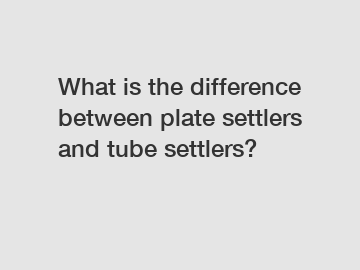Dec. 18, 2023
Agriculture
In the realm of water treatment, there are numerous techniques and technologies employed to purify water and remove impurities. Plate settlers and tube settlers are two commonly used methods to facilitate the settling of suspended solids in water. While both serve a similar purpose, there are distinct differences between them in terms of their design, efficiency, and applications. In this article, we will delve into the world of plate settlers and tube settlers, uncovering the unique characteristics that set them apart.
Understanding Plate Settlers:
Plate settlers, also known as lamella settlers, are rectangular or square-shaped structures consisting of several inclined plates stacked closely together. These plates create a series of settling chambers within the unit. As water flows through these chambers, suspended particles and solids collide with the inclined plates and gravitate towards the bottom, eventually settling down under the influence of gravity. The settled solids are typically removed through a sludge collection mechanism.

The Advantages of Plate Settlers:
Plate settlers offer several advantages, making them a popular choice for water treatment applications. Firstly, their compact design allows for an efficient use of space, making them suitable for retrofitting into existing water treatment plants. Secondly, the inclined plates provide a large surface area for solids to settle, enabling high removal efficiency even in limited space. Lastly, plate settlers are relatively simple to operate and require minimal maintenance, making them cost-effective in the long run.
Unlocking the Power of Tube Settlers:
Tube settlers, also called lamella tubes, bring a cylindrical twist to the water settling process. Unlike plate settlers, they consist of multiple interconnected tubes arranged vertically or at an inclined angle. The tubes are typically hexagonal in shape and provide the necessary surface area for solids to settle. As water passes through these tubes, the flow pattern is modified, causing solids to collide with the tube walls and move downward due to gravity.
The Benefits of Tube Settlers:
Tube settlers have their own unique set of advantages, making them an attractive alternative to plate settlers. Firstly, the design of tube settlers enhances the formation of particle-to-particle contact, resulting in improved settling rates and enhanced particle removal efficiency. Additionally, the open-tube structure minimizes the risk of clogging, allowing for continuous water flow and reducing the need for frequent maintenance. The lightweight material used in tube settlers also makes them more resistant to corrosion, ensuring longevity.
When to Choose Plate Settlers or Tube Settlers?
The choice between plate settlers and tube settlers largely depends on the specific requirements of the water treatment application. Plate settlers are often preferred in applications where limited space is available or retrofitting is necessary. Their compact design and efficient use of space make them ideal for diverse settings, including municipal water treatment plants, wastewater treatment facilities, and industrial processes.
On the other hand, tube settlers shine in applications that demand high efficiency and easy maintenance. They are particularly effective in removing fine particles and can be used in both rectangular and circular basins. Tube settlers are commonly found in water treatment systems, such as sedimentation tanks, clarification units, and settling tanks. Their versatility and robust performance make them a reliable choice for various industries.
Conclusion:
In summary, plate settlers and tube settlers play significant roles in facilitating the settling of suspended solids in water treatment processes. While both methods share the same objective, their design and unique characteristics set them apart. Plate settlers offer compactness, efficiency, and simplicity, while tube settlers excel in enhancing particle contact, minimizing clogging, and promoting operational ease. By understanding the differences between these settling technologies, water treatment experts can make informed decisions regarding their deployment, ensuring cleaner and safer water for communities and industries alike.
If you are looking for more details, kindly visit fine diffuser, cooling tower diffuser, cooling tower function.
Previous: All you need to know about Chinese Hami Melon Seeds: Health benefits, recipes, and where to buy!
Next: Revolutionize Your Garden: The Ultimate Mop Fertilizer Guide
If you are interested in sending in a Guest Blogger Submission,welcome to write for us!
All Comments ( 0 )